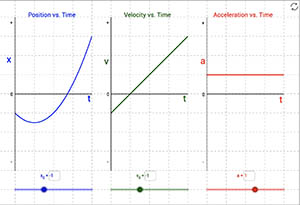

At the same time, the second slope (ii) with a downward slope determines the negative velocity. In the above figure, the first figure (i) shows the positive velocity and upward slope. Positive and Negative Slope of Position Time Graph Which eventually means that body is decelerating. If the position is decreasing with time, the slope gives negative velocity. If the velocity increases, then the body is accelerating. Then the velocity increases or remains constant. If the position of the graph is increasing with time, then the slope is also positive velocity. If the slope is steeper, it tells that the velocity is greater.

We know the displacement/ time gives us the value of velocity. The slope of this graph is determined as: The slope of the position vs time graph is called velocity it is also termed as displacement per unit time. What is slope of a position vs time graph called Therefore the position of the object is 2 meters in 5 seconds. We can see that when the time t = 5 seconds, the position axis is marked at 2 m. Therefore the velocity of the object in that particular time would be 2 m/s.įor the above graph, how will we find the position of the body when time equals 5 seconds. The next step is to calculate the slope as: From these two points, we draw perpendicular lines. Suppose we are given the position-time graph as above, now to determine the slope of the graph, we take two points as A and B on the line. The value can also be zero in case the slope line is parallel to the time axis. Therefore the slope of a position-time graph can be positive, negative, constant or changing by making a curved line. For instance, a small slope signifies a smaller velocity a negative one leads to a negative value of velocity.Īt the same time, a constant slope determines the constant velocity, and if the slope keeps changing, that is, a curved line leads to a changing velocity. It tells vital information about the velocity of a particular object. The slope of the position-time graph reveals the magnitude of the velocity of a moving particle. What does the slope position-time graph signify By following the steps described above, we can determine the value of the slope. The slope of position time graph is found by plotting the graph, and then on joining the points, we get a line either rising up or down. The steepness, length and shape of the graph determine how an object is moving. from the graph, we get to know about its position at any particular time. It determines the motion of the object, i.e. What is the slope of position time graphįor the position and time graph, we take one quantity on the x-axis and the other one on the y-axis. If the slope runs downward, as shown in figure (ii), then it is taken to be negative. Slope=rise/run Slope of the graph Positive and Negative Slopeįrom moving from left to right, if the slope runs upward, as shown in figure (i), then it is taken as positive. The slope thus is the ratio between the rise and run, that is: Draw the vertical line from one point that is known as rising, and a horizontal line from another called to rise. To calculate the slope of the graph, take two points on the line. Just by looking at the slope, you can know a lot about the given graph. The steepness of the slope tells about the direction of the given quantity. From the points on the slope, we can find the velocity at a given time. The slope of position and time graph represents the velocity of the subject. It infers how far an object moves in a given time. This article is about the slope of position time graph.Ī position-time graph of an object represents position and time on the two respective axes. The graph is the representation of any two physical quantities with respect to each other.


 0 kommentar(er)
0 kommentar(er)
